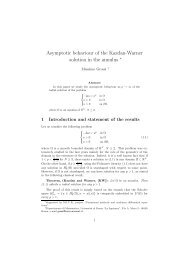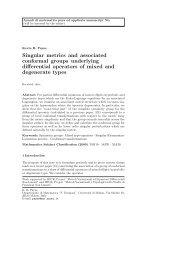Degree of Parabolic Quantum Groups - Dipartimento di Matematica ...
Degree of Parabolic Quantum Groups - Dipartimento di Matematica ...
Degree of Parabolic Quantum Groups - Dipartimento di Matematica ...
Create successful ePaper yourself
Turn your PDF publications into a flip-book with our unique Google optimized e-Paper software.
1. Poisson algebraic <strong>Groups</strong> 3<br />
Definition 1.1.5. 1. Let M and N be smooth Poisson manifolds. A<br />
smooth map f : M → N is called a Poisson map if the induced map<br />
f ∗ : C ∞ (N) → C ∞ (M) is a Poisson homomorphism.<br />
2. Let M and N be algebraic Poisson k-variety. An algebraic map f :<br />
M → N is called a Poisson map if the induced map f ∗ : k[N] → k[M]<br />
is a Poisson homomorphism.<br />
It is clear that smooth, and algebraic, Poisson manifolds form a category,<br />
with morphisms being Poisson map.<br />
Definition 1.1.6. Suppose that M is a smooth Poisson manifold, let A =<br />
C ∞ (M).<br />
1. Given φ ∈ A, the vector field ξφ associated to the Hamiltonian derivation<br />
{φ, } <strong>of</strong> A is called Hamiltonian vector field.<br />
2. A submanifold (not necessarily closed) N ⊂ M is called Poisson submanifold<br />
if the vector ψφ(n) is tangent to N for any n ∈ N and φ ∈ A.<br />
Let M a smooth Poisson manifold, then there is an equivalent definition<br />
<strong>of</strong> Poisson manifold in term <strong>of</strong> bivector fields. Recall that an n-vector field<br />
is a section <strong>of</strong> the bundle n TM where TM is the tangent vector bundle <strong>of</strong><br />
M. In particular, we call 2-vector fields bivector fields.<br />
Recall also the definition <strong>of</strong> the Schouten bracket <strong>of</strong> n-vector fields which<br />
generalize the usual Lie bracket on vector fields. The Schouten bracket <strong>of</strong><br />
an m-vector field with an n vector field is an (m + n − 1)-vector field which<br />
is locally defined by<br />
[u1 ∧ . . . ∧ um, v1 ∧ . . . ∧ vm]<br />
= <br />
(−1) i+j [ui, vj] ∧ u1 ∧ . . . ∧ ûi ∧ um ∧ v1 ∧ . . . ∧ ˆvj ∧ . . . ∧ vn<br />
i,j<br />
where u1, . . .,um, v1, . . .,vn ∈ TmM, m ∈ M, and [, ] denote the Lie bracket<br />
<strong>of</strong> vector fields.<br />
Denote by T ∗ M the cotangent bundle to M. Given a bivector field π on<br />
M, we define a bilinear operation { , } on C ∞ (M) by<br />
{φ, ψ} = 〈π, dφ ∧ dψ〉 (1.1)<br />
where 〈, 〉 is the natural paring between the sections <strong>of</strong> the bundle T ∗ M ∧<br />
T ∗ M and TM ∧ TM.<br />
Proposition 1.1.7. The bracket 1.1 defines a Poisson manifold structure<br />
on M if and only if<br />
[π, π] = 0








